By Nick Angus | @n_angus23
In today’s chaotic yet compelling world of cinema and television, prequels, sequels and remakes have become something of a norm. The desire to revitalise or reintroduce a particular story is a strong motivation for the modern director, as he or she perseveres to make their name known within the industry. However, it’s this approach to producing new visual entertainment that has proven quite a dangerous tightrope – dangerous, because the road to success comes with a handful of potential consequences, whether it be losing the accuracy and enjoyment achieved in the original production or, even worse, causing the downfall of an entire franchise.
Foxtel’s new six-part Showcase-produced television miniseries Picnic at Hanging Rock walks this very tightrope, all while juggling a prominent cast, vivid themes and story with over fifty years of existence.
The original 1967 novel written by Joan Lindsay tells the story of the disappearance of three young school girls and their governess during a school field-trip to the picturesquely haunting Hanging Rock on Valentine’s Day, a year before Australian Federation. As the days pass and their disappearance remains eminent, tension at Appleyard College and the surrounding township bubbles profusely, letting suspicion, accusation and anger erupt. Before long, the population at Appleyard College has diminished significantly, leaving the fate of college headmistress, Mrs. Appleyard, to undeniably hang in the balance. By the end of the novel, only one of the four women has been found, with the remaining three individuals lost forever to the harsh Australian outback…or so we believe.
To say the 2018 television miniseries ‘plays’ with the story would be an understatement. As a collaboration between three different directors, this adaptation threads the story along new and daring pathways, highlighting themes of individuality, injustice and the risky battle against sexual oppression. However, akin to the proverb of “too many cooks spoil the broth”, it becomes the case with this television miniseries that “too many themes (somewhat) spoil the story”. The frequent shifting between a multitude of themes tends to cause confusion around the tone the series is trying to evoke, often leading to misconceptions about several characters and events.
Despite this, Natalie Dormer (Game of Thrones) and Lily Sullivan (Mental) excel as the roguish Mrs. Appleyard and rebellious Miranda Reid respectively. Being the most prominent roles, it’s pleasing to notice a balanced screen time between them, with equal focus given to both their backstories as well as their fuelling of the toxicity that exists within the gates of Appleyard College. These angles form major fragments of the narrative, allowing the audience a break from the looming disappearance which dominates the remainder of the famous storyline.
So why is it that this picnic has remained so uniquely in the public consciousness for the past fifty years?
We never know what happened to Miranda Reid or Marion Quade or Miss McCraw. Where did they go? Did they survive? What really happened at the Rock? Ultimately, we never get an ending to this story. For many, a lack of an ending can be frustrating, even disappointing. However, it’s this lack of an ending for this particular story that continues to invigorate and excite us. We visit the Rock, we scream Miranda’s name and we imagine our own ending. Put simply, we keep the story alive.
While the new miniseries does come with its faults, it certainly succeeds in keeping the story alive. Fresh faces, vivid locations and a well composed soundtrack all make for an eerie but entertaining experience while modern cinematography help in revitalising the story to something more visually pleasing. And while the themes are expressed somewhat on top of one another, there is a strong sense of character development throughout the six episodes, which aids in prompting the viewer to continue watching and maybe just get to bed a little later than usual.
The Picnic at Hanging Rock tale seems to be never-ending. We’ve lost Miranda, been distraught with Mrs. Appleyard and angry at Irma Leopold numerous times now, with no actual further insight into what even happened. It seems that sometimes we must witness something many times to realise that, in fact, the truth is better hidden than exposed.


